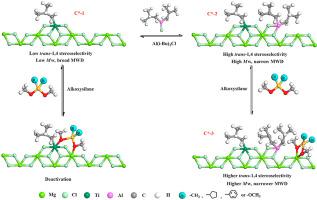Polymer ( IF 4.6 ) Pub Date : 2021-09-18 , DOI: 10.1016/j.polymer.2021.124207 Qingtao Niu 1 , Manman Jin 1 , Aihua He 2 , Tielong Chen 3 , Guodong Liu 1 , Chongdian Si 1

|
External electron donors (ED) play significant roles in regulating stereoselectivity and catalytic activity of MgCl2-supported (TiCl4/MgCl2) type Ziegler-Natta catalysts. Investigating the contribution of ED on copolymerization of isoprene (Ip) and butadiene (Bd) with TiCl4/MgCl2 Ziegler-Natta catalysts is little reported. Herein, we reported the effects of three alkoxysilanes including dimethyldimethoxysilane (DMDMS), diphenyldimethoxysilane (DPDMS), phenyltrimethoxysilane (PTMS) added as ED on trans-1,4 stereoselective copolymerization of Ip and Bd using TiCl4/MgCl2-triisobutylaluminium (Al(i-Bu)3) catalyst system. Copolymers generated by TiCl4/MgCl2 catalyst in the absence of ED featured the microstructure transformation from cis-1,4 and trans-1,4 mixed microstructure on initial stage to trans-1,4 dominated microstructure and the molecular weight (Mw) evolution from low Mw to high Mw, indicating the transformation from low trans-1,4 stereoselective active center C*-1 to high trans-1,4 stereoselective active center C*-2. Appropriate introduction of alkoxysilane donors improved the polymerization activity, trans-1,4 unit content and molecular weight of copolymer in the order of PTMS > DPDMS > DMDMS, while excess alkoxysilane donors caused the decrease in that of polymerization behaviors. Increasing polymerization temperature also promoted the enhance in catalytic activity and trans-1,4 stereoseletivity of TiCl4/MgCl2 catalyst in the presence of ED. The equilibrium between deactivation and activation effect strongly depended on alkoxysilane structure, concentration and temperature. Plausible mechanisms for stereoselective transformation of active centers in Ip and Bd copolymerization using MgCl2-supported type Ziegler-Natta catalyst were proposed in terms of special roles of ED.
中文翻译:

外给电子体对异戊二烯和丁二烯与MgCl2负载的齐格勒-纳塔催化剂立体选择性共聚的影响
外部电子给体(ED)在调节 MgCl 2负载型(TiCl 4 /MgCl 2)型齐格勒-纳塔催化剂的立体选择性和催化活性方面发挥重要作用。研究 ED 对异戊二烯 (Ip) 和丁二烯 (Bd) 与 TiCl 4 /MgCl 2 Ziegler-Natta 催化剂共聚的贡献的报道很少。在本文中,我们报道三个烷氧基硅烷的效果,包括加入作为ED上二甲基二甲氧基硅烷(DMDMS),二苯基(DPDMS),苯基三甲氧基硅烷(PTMS)反式-1,4-叶和BD用的TiCl的立体选择性共聚4 /的MgCl 2 -triisobutylaluminium铝(Al(我-Bu) 3) 催化剂系统。TiCl 4 /MgCl 2催化剂在没有ED的情况下生成的共聚物的特征是微观结构从初始阶段的顺式-1,4和反式-1,4混合微观结构转变为反式-1,4主导的微观结构和分子量(M w ) 从低M w到高M w 的演变,表明从低反式-1,4 立体选择性活性中心 C*-1 到高反式-1,4 立体选择性活性中心 C*-2的转变。烷氧基硅烷给体的适当引入提高了聚合活性,反式-1,4单元含量和共聚物的分子量顺序为PTMS > DPDMS > DMDMS,而过量的烷氧基硅烷给体导致聚合行为的降低。在ED存在下,提高聚合温度也促进了TiCl 4 /MgCl 2催化剂的催化活性和反式-1,4立体选择性的提高。失活和活化效果之间的平衡强烈依赖于烷氧基硅烷的结构、浓度和温度。根据ED的特殊作用,提出了使用MgCl 2负载型Ziegler-Natta催化剂在Ip和Bd共聚中立体选择性转化活性中心的合理机制。


























 京公网安备 11010802027423号
京公网安备 11010802027423号